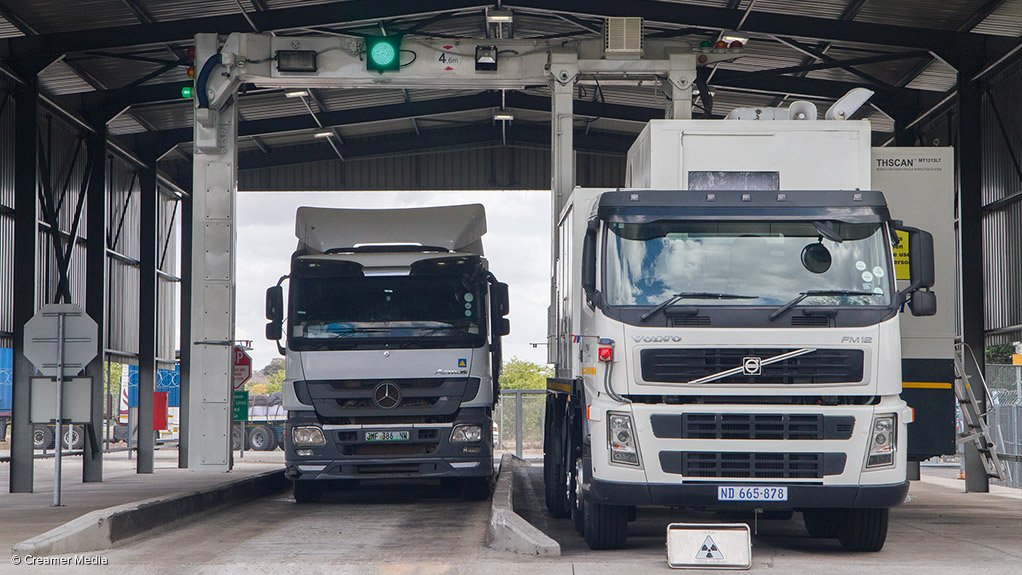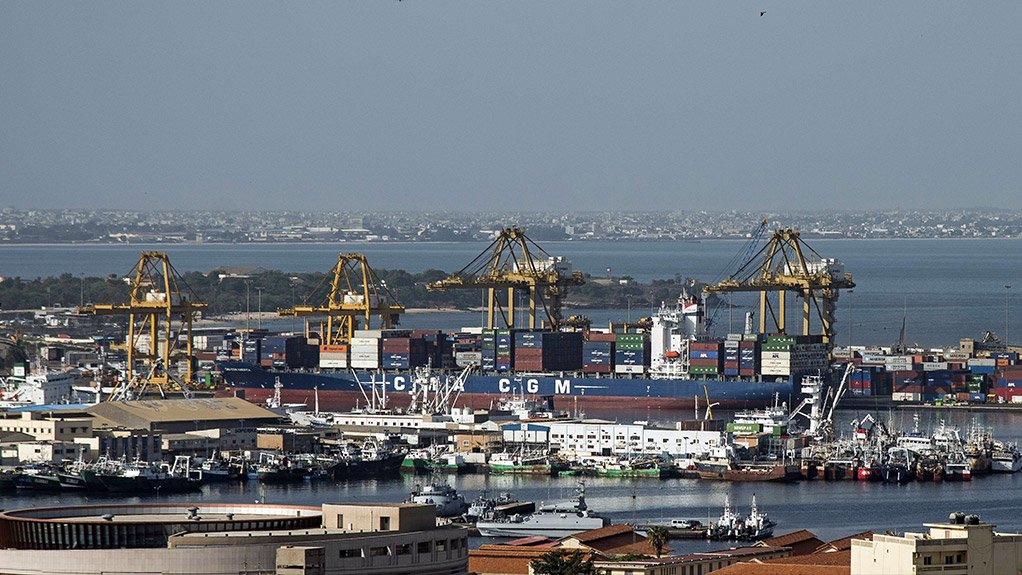Funding for SA firms seeking to increase African trade and investment exposure






PORTIA DUBE Support for export investments brings advantages to the South African economy
BORDER SCANNER An X-ray scanner at the Beitbride border post scans a truck
Photo by Duane Daws
PORT OF DAKAR The CMA CGM container terminal in Dakar, Senegal
Photo by Bloomberg
TRADE INFRASTRUCTURE A reach stacker loads a container onto a waiting train in Musina, South Africa
Photo by Duane Daws
Hopes for bolstering South Africa’s anaemic economic performance through increased intraregional trade and investment have been raised with the launch of the R13.4-billion South African Trade and Investment Promotion Programme (SATIPP) fund by the Export Credit Insurance Corporation of South Africa (ECIC) and the African Export Import Bank (Afreximbank).
The programme provides resources for South African exporters and South African investors looking for partnerships in other African countries. The fund is available to goods and services exporters operating in South Africa, says Department of Trade and Industry (DTI) trade and investment deputy director-general Lerato Mataboge.
The aim of the SATIPP is to facilitate the expansion of South Africa’s trade with and investment in the rest of Africa to promote regional economic integration.
“Exports contribute 32% of gross domestic product and there is a critical need to decisively support the export drive in our country to not only boost existing exporters but also create new exporters.
“Our priority is to establish an export culture among South African enterprises and encourage entrepreneurs to always think globally. With a market of 57-million people, saturation can limit the growth of companies and there is a critical need to facilitate access to new markets and maintain access to our traditional markets,” she explains.
Companies that are export ready can use the financial packages and assistance of the DTI, Afreximbank and the State-owned ECIC to facilitate exports and export-orientated investments.
The SATIPP adds to a basket of resources and support. The fund has an open-ended term, expects to see good uptake within a year and aims to disburse the funds rapidly, says Mataboge.
“A similar trade and investment scheme in Egypt was utilised within two years. We have the option to top up the fund if there is [good appetite for it]. However, this depends on the uptake by South African exporters of goods and services. We encourage the private sector to use the facility.”
Afreximbank, based in Cairo, has 25 years of experience in facilitating trade in African and developing markets, she adds, noting that the trade and insurance tools and solutions provided by Afreximbank and the ECIC adhere to international trade financing best practices and standards.
The ECIC is focused on providing political and commercial risk insurance to facilitate trade for the export of capital goods, services and cross-border investments for South African exporters, while Afreximbank provides credit lines, guarantees and information about opportunities in regional supply chains aimed at increasing value-added content, says ECIC head of business development Portia Dube.
Risk Sharing
Additionally, the collaboration with Afreximbank also provides potential risk-sharing between the ECIC and Afreximbank on transactions resulting in fully funded solutions, as well as nonfinancial benefits, she says.
The ECIC publishes research papers and highlights opportunities within its country research papers. Further, Afreximbank has an established library of information that focuses on improving the capacity of Africa in trade finance and facilitating market access for South African exporters. It also drives policy advocacy initiatives.
Increasingly, the ECIC’s Business Development Unit acts as a catalyst by helping buyers and exporters with assessment of transaction structures early in the process. It also connects buyers with potential South African contractors and lenders, as well as with project preparation funders for feasibility studies to get projects to bankable stage, she explains.
“Our mandate is focused on supporting the export of capital goods and services medium- to long-term financing structures, while Afreximbank can support the short-term trade products and instruments. This supports the growth of intra-African trade.”
The South African Development Community (SADC) has helped to grow intra-SADC trade. Regional trade blocs the Economic Community of West African States and the Common Market for Eastern and Southern Africa, as well as the tripartite trade agreements between them, provide better alignment of trade rules between countries and the standardisation of tariffs and duties, adds Mataboge.
The newly signed Continental Free Trade Agreement will further help to improve trade integration. South Africa will also open its borders to greater trade with Africa, and the DTI is arranging meetings with local retailers to inspect products from other African countries, she says.
“Free trade meets all the hard-core economic conditions for growth. Free trade can provide a host of benefits, including increasing labour productivity, improving labour absorption and the terms of trade,” start-up organisation 22 on Sloane research resident adviser and former statistician-general Dr Pali Lehohla said in an opinion piece in news media company Independent Online in July.
High performance in the production of goods and services in the economy, and their subsequent export, improves the terms of trade and increases the levels of employment, provided social policies are geared to improve education. This ensures society will not be outpaced by technology, nor see it as a hindrance to progress, he avers.
The SATIPP seeks to stimulate development in trade partners to improve long-term benefits and the sustainability of trade. This means that investment in countries and in trade infrastructure, and ensuring skills are transferred are key aspects of the SATIPP.
“Job creation and enterprise development in the countries we trade with are as important as the anticipated impact on our own employment and industrialisation,” explains Mataboge.
“Services exports, especially engineering services and architectural services, are also supporting the development of infrastructure in Africa.”
The support mechanisms of the SATIPP dovetail with other DTI resources and services, she adds.
South Africa already exports engineering and architectural services into Africa. However, project preparation is a challenge to many infrastructure projects and South African companies can play their role in infrastructure development. The DTI makes the Capital Projects Feasibility Programme available as a cost-sharing mechanism to mitigate this gap.
“We need to move towards a partnership with the private sector to accelerate infrastructure development. Beyond their objective for profit maximisation, there are opportunities for the private sector to play a developmental role in delivering success for our continent,” highlights Mataboge.
Reciprocal Boost
Stimulating the creation of a value chain is critical to the long-term sustainability and commensurate developmental impact of trade, and this is the reason why the SATIPP provides resources for trade and investments in any country in Africa, she says.
“If we get regional and continental integration right, we form a market of one-billion people and a combined gross domestic product of about $3-trillion. Therefore, better regional integration not only benefits intra-African trade but also makes the continent more attractive to other trading blocs and partners. This will improve the bankability and viability of trade and investment in Africa.”
The expertise of Afreximbank and the ECIC will facilitate growth of South African small and medium-sized enterprises by allowing them to expand their exports through credit facilities and other risk-mitigation instruments.
Support for investments and exports creates an opportunity for South African companies to expand and has advantages for the South African economy, resulting in domestic expansion to serve or meet the demand of growth into new markets. When companies grow beyond borders, it results in regional value chains, which contribute to diversification and revenue growth, notes Dube.
“This is a win-win approach that provides benefits for South Africa, trade partners and within the host country and is in line with the aggregate content requirements for South Africa and the host country.”
Transactions supported by the ECIC under the SATIPP must comply with the 70% content requirement, which comprises 50% minimum South African content and 20% content from the host or other African countries for projects on the African continent, she says.
“The expertise and labour required to fulfil a project also contribute to the value added by South Africa, or, conversely, added in the host country by its own people. Similarly, the drive to stimulate investments is a win-win proposition and bolsters the ambitions to grow intra-African trade,” Dube adds.
“The expectations that we have of companies in South Africa that use this trade and investment facility is that they leave a legacy of development, job creation and skills transfer in every market they operate in,” highlights Mataboge.
The programme supports the private sector in an effort to improve the levels of trade and investment, as well as its own growth and expansion, and is focused on the long-term return on investment and growth of the regional economy.
“By facilitating the development of skills and the creation of jobs, we also open markets to symbiotically improve our own and our trade partners’ development. We must ensure that skills transfer and enterprise and job creation are in place in the companies and countries we invest in. This is how the private sector becomes a partner in development,” she concludes.
Comments
Announcements
What's On
Subscribe to improve your user experience...
Option 1 (equivalent of R125 a month):
Receive a weekly copy of Creamer Media's Engineering News & Mining Weekly magazine
(print copy for those in South Africa and e-magazine for those outside of South Africa)
Receive daily email newsletters
Access to full search results
Access archive of magazine back copies
Access to Projects in Progress
Access to ONE Research Report of your choice in PDF format
Option 2 (equivalent of R375 a month):
All benefits from Option 1
PLUS
Access to Creamer Media's Research Channel Africa for ALL Research Reports, in PDF format, on various industrial and mining sectors
including Electricity; Water; Energy Transition; Hydrogen; Roads, Rail and Ports; Coal; Gold; Platinum; Battery Metals; etc.
Already a subscriber?
Forgotten your password?
Receive weekly copy of Creamer Media's Engineering News & Mining Weekly magazine (print copy for those in South Africa and e-magazine for those outside of South Africa)
➕
Recieve daily email newsletters
➕
Access to full search results
➕
Access archive of magazine back copies
➕
Access to Projects in Progress
➕
Access to ONE Research Report of your choice in PDF format
RESEARCH CHANNEL AFRICA
R4500 (equivalent of R375 a month)
SUBSCRIBEAll benefits from Option 1
➕
Access to Creamer Media's Research Channel Africa for ALL Research Reports on various industrial and mining sectors, in PDF format, including on:
Electricity
➕
Water
➕
Energy Transition
➕
Hydrogen
➕
Roads, Rail and Ports
➕
Coal
➕
Gold
➕
Platinum
➕
Battery Metals
➕
etc.
Receive all benefits from Option 1 or Option 2 delivered to numerous people at your company
➕
Multiple User names and Passwords for simultaneous log-ins
➕
Intranet integration access to all in your organisation























